In cycling – whether on the pristine boards of the velodrome, the Parisian cobbles of the Tour De France, or the muck and gravel of the trails – lightweight is king.
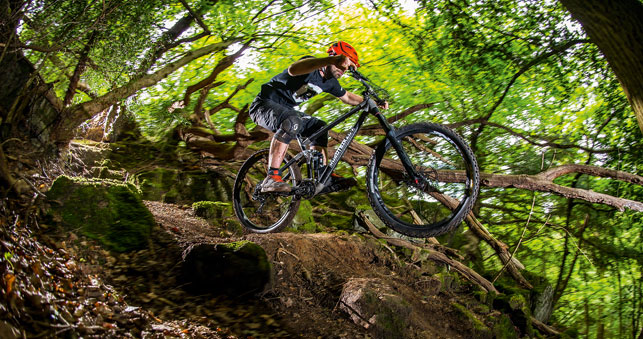
The Robot Bike Company R160 full suspension mountain bike in action on the trails
This desire to shave grams off its two-wheeled creations is why the Robot Bike Company (RBC), which is based near Monmouth in Wales, is turning to optimised design and 3D printing.
The challenge the company set itself was to create a fully customisable bike frame for full production, which could make the best of 3D printed titanium brackets and fixtures, connecting strong, light, carbon fibre tubes.
Christened the R160, nobody is under any illusion that it will be a mass market product. These will be high end, built to order and personally tailored to an individual’s weight, height, and riding style – but they will, in RBC’s words, be the ‘best bike frames possible’.
“If you are trying to produce the very best frame it makes no sense to then only offer it in a small number of sizes when the people you are selling it to come in all shapes and sizes,” says RBC CEO Ed Haythornthwaite, adding that customers should think of Robot Bike Company as the “Savile Row of the bike world.”
Like the made-to-measure suits this bespoke elegance comes at a cost starting at over £4,000 with a production lead time of four weeks.
Partnering up
Founded in 2013 by a crack team of bike designers, riders, fixers and crashers, RBC has considerable experience in mountain bike design. However, despite its in-house design and engineering skills, in order to turn its ambition into a workable business, the team realised that it would require multiple partnerships with industry experts. So, it approached HiETA Technologies, a specialist in design and engineering solutions for additive manufacturing technologies.
Based in the Bristol and Bath Science Park, HiETA employs 25 specialist engineers to cover the full product design, manufacturing readiness and project management.
Mike Adams CEO of HiETA, says: “One of the great aspirations of additive manufacturing has always been mass customisation.
“Leading this project has allowed us to see integration of all the elements – a great new frame design, the use of state of the art software tools for optimisation and automation, the flexibility of the manufacturing process itself and effective collaboration between our partners is a great advert for the technologies and the South West of England showcasing that the aspiration is becoming a reality.”
Optimising the design
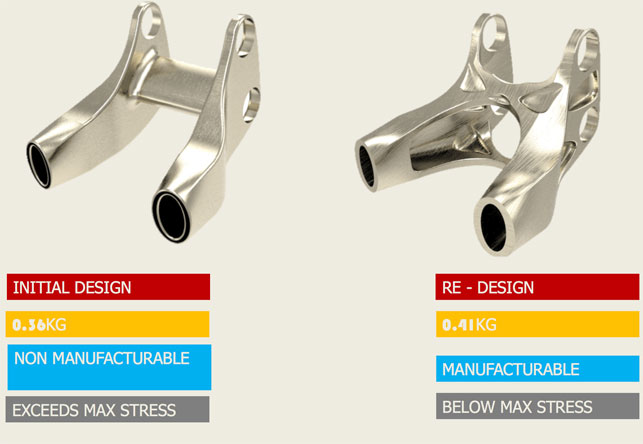
Comparison between the original and optimised design nodes
The design was split into sections, between carbon fibre framework and the connecting nodes that would be 3D printed in titanium.
Altair ProductDesign, simulation software specialist Altair’s in-house design team, was made responsible for the optimisation of the bike’s additively manufactured connectors.
Using SolidThinking Inspire, the Altair team was able to maximise the benefit of additive manufacturing by identifying where material in the connectors could be removed to save weight and reduce part count without compromising performance.
Although the optimisation technology is more commonly used in high-end automotive and aerospace industries to maximise product performance, it is equally valuable to bike manufacturers.
Altair ProductDesign’s first task was to perform the optimisation studies on each node in the frame as early in the design process as possible. This way they could find a material efficient design that met the required performance characteristics and could be sized for different riders’ specifications.
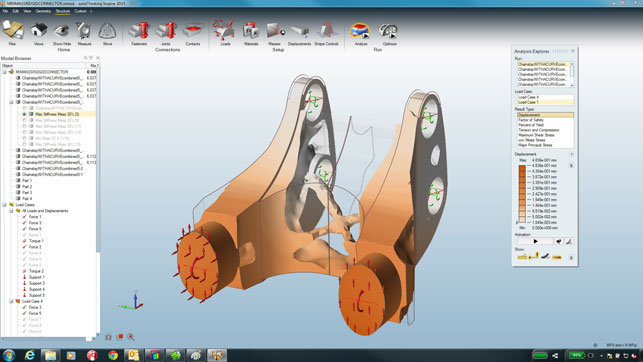
Using SolidThinking Inspire, the team could create a design that maximises frame stiffness
The existing RBC node designs were taken into the Inspire virtual environment and a variety of loading data that the bike frame would be required to withstand during use was applied.
The software output a new geometry layout maximising the efficiency of the material layout while still achieving all performance targets.
Benefits of technology
Throughout the process the new designs had to also be optimised for the additive manufacturing process, which included determining the ideal print angle and placement of the supporting structure to avoid the component collapsing during manufacturing. This process was conducted in conjunction with HiETA Technologies.
In addition to designing weight efficient components, Altair ProductDesign was also able to look for opportunities to simplify the frame design to lower the cost of production.
One such example was the chain stay lug which was originally a three-piece assembly of two symmetric titanium components and an interlinking carbon fibre tube. Utilising both solidThinking’s Inspire for optimisation, and Evolve for final part refinement, the team was able to build in the additive manufacturing requirements from HiETA Technologies, to redesign the lug as a single component, optimised for mass, performance, and manufacturing cost.
“This has been a very interesting and exciting project to be involved with,” comments Paul Kirkham, Altair’s project team leader.
“Additive manufacturing is the perfect partner for design optimisation techniques as it allows us to produce components and systems that are far closer to the ideal balance of weight and performance.
“Robot Bike Company now have a design that will offer its customers a bike that is truly innovative and unique.”
Into production
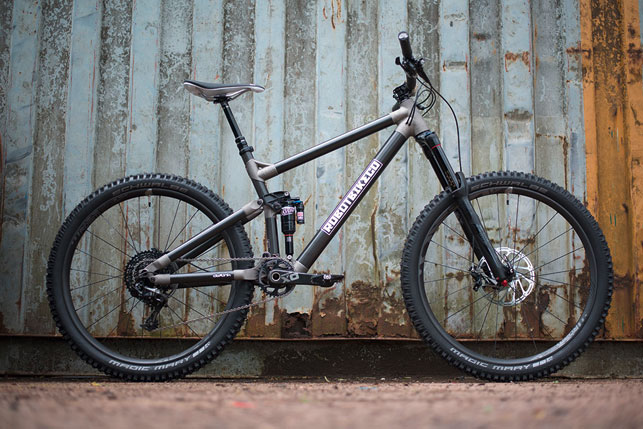
The final £4,000 build
The final parts were produced in the UK by Renishaw, with the company lending further expertise in 3D printing the parts, post processing machining and metrology to deliver the custom titanium nodes.
Renishaw’s Marc Saunders, director of the company’s Global Solutions Centres, suggests that this kind of project is where the benefits of additive manufacturing shine through.
He adds: “This typifies the approach that we are taking with our Solutions Centres, where we are working closely with our customers to create designs that maximise the production and lifetime benefits that can be gained from using an additive manufacturing process.”
Combining advanced software, the latest manufacturing processes and bespoke geometry, the R160 project is at the leading edge of mountain bike technology, but one open to anyone that wants to pelt down mountain trails for the foreseeable future.
robotbike.co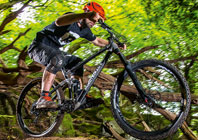
Mountain biking meets aerospace engineering
Default






